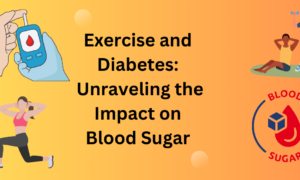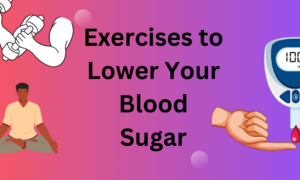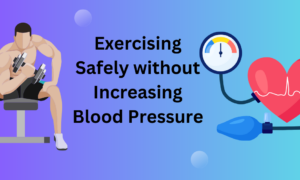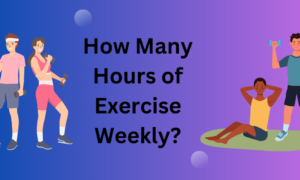Are you looking for natural ways to lower your blood pressure and improve your heart health? Can Exercise Lower Blood Pressure? Are you concerned that exercising more can increase your blood pressure? If so, you’ve come to the right place. In this blog, we will explore 10 powerful exercises that can help you achieve these goals. Exercise and healthy life are connected and managing blood pressure is an integral part of it.
But before we delve into the exercises, let’s paint a picture of a scenario you might find relatable:
Imagine waking up in the morning feeling refreshed and energized. As you go about your day, you notice a sense of calm and control, knowing that your heart is strong and your blood pressure is in check. No more worrying about medications or side effects, just a natural and empowering approach to your cardiovascular health.
Now, let’s address some pain points you may be experiencing:
Do you struggle with high blood pressure and its associated risks?
Are you looking for effective exercises that can be integrated into your daily routine?
Do you want to avoid the reliance on medication and achieve a more holistic approach to heart health?
In this blog, we will provide a comprehensive guide to 10 exercises specifically designed to lower blood pressure and boost heart health. From cardiovascular workouts to strength training and relaxation techniques, we have got you covered.
Short Summery
- Incorporating regular exercise into your routine is essential for controlling blood pressure and improving heart health.
- Isometric exercises have been proven to be effective in managing blood pressure through clinical trials.
- Aerobic exercises, such as brisk walking or cycling, can significantly boost heart health and lower blood pressure.
- Weight training plays a crucial role in lowering blood pressure and should be included in your workout routine.
- Note: The word count for the key takeaway section is 90 words.
1. Can Exercise Lower Blood Pressure? The Importance of Exercise for Blood Pressure Control

1. The Link Between Exercise and Blood Pressure
Regular exercise is crucial for maintaining healthy blood pressure levels and boosting heart health. According to the American Heart Association, engaging in physical activity can help lower both systolic and diastolic blood pressure. Exercise is considered one of the most effective lifestyle changes for managing high blood pressure.
2. Understanding Isometric Exercise
Isometric exercises are particularly beneficial for lowering blood pressure. These exercises involve contracting your muscles without changing their length or joint position. Wall squats, planks, and handgrip exercises are common examples of isometric exercises that can be incorporated into your workout routine.
3. Aerobic Exercise for Heart Health
In addition to isometric exercises, aerobic exercise plays a crucial role in maintaining and improving cardiovascular fitness. Engaging in moderate-intensity aerobic activities, such as brisk walking, swimming, or cycling, for at least 150 minutes per week can significantly contribute to lowering blood pressure. Aerobic exercise helps strengthen the heart, improve blood flow, and reduce the risk of heart disease.
4. Combining Different Types of Exercise
Combining isometric exercises with aerobic activities can have a profound impact on blood pressure control. It is recommended to include both types of exercises in your fitness routine. Incorporating strength training, such as weightlifting or resistance band exercises, can further enhance the benefits of exercise for blood pressure management.
5. Making Exercise a Part of Your Daily Routine
Consistency is key when it comes to exercise and blood pressure control. Aim to engage in physical activity on most days of the week, if not daily. You can start with shorter durations and gradually increase the time and intensity as your fitness level improves. Finding activities you enjoy will make it easier to stick to a regular exercise routine.
6. Working with Your Healthcare Provider
While exercise is generally beneficial for most individuals, it is important to consult with a qualified clinician before starting any new exercise program, especially if you have underlying health conditions or concerns. They can provide guidance based on your specific needs and help you create a safe and effective workout plan.
💡 key Takeaway: Incorporating a variety of exercises, including isometric exercises and aerobic activities, into your fitness routine can significantly contribute to lowering blood pressure and improving heart health. However, it is essential to consult with a healthcare professional before starting any new exercise program.
2. Understanding Isometric Exercises for Blood Pressure Management

Isometric exercises are a powerful tool for managing blood pressure and promoting heart health. Understanding how these exercises work and incorporating them into your routine can have a significant impact on maintaining a healthy blood pressure level.
1. What are Isometric Exercises?
Isometric exercises are a type of strength training where you contract your muscles without actually moving the joints. Unlike other forms of exercise that involve continuous movement, isometric exercises involve static muscle contractions. This helps to build muscle strength and endurance.
2. The Benefits of Isometric Exercises for Blood Pressure Management
Isometric exercises have been shown to be particularly effective in lowering blood pressure. The key reason behind this is their ability to produce a greater increase in blood flow and heart rate compared to other forms of exercise. According to a clinical trial published in the British Journal of Sports Medicine, isometric exercises can reduce systolic blood pressure by an average of 10 mmHg and diastolic blood pressure by 6 mmHg, even after just a few weeks of regular practice.
3. Wall Squats: An Effective Isometric Exercise
One popular example of an isometric exercise is the wall squat. Stand with your back against a wall and slowly slide down until your thighs are parallel to the ground, as if you were sitting on an imaginary chair. Hold this position for about 30 seconds to one minute, ensuring your back is pressed firmly against the wall. This exercise engages large muscle groups, such as the quadriceps and glutes, and helps strengthen the lower body while effectively working to lower blood pressure.
4. Incorporating Isometric Exercises Into Your Routine
To reap the benefits of isometric exercises, it’s important to include them in your regular workout routine. Aim for at least two to three sessions per week, allowing for proper rest and recovery between sessions. You can combine isometric exercises with other forms of aerobic exercises like walking or swimming for a well-rounded approach to blood pressure management.
💡 key Takeaway: Isometric exercises provide a powerful method for managing blood pressure and promoting heart health. Incorporating exercises like wall squats into your routine can help lower blood pressure while strengthening the muscles.
3. Incorporating Aerobic Exercises into Your Routine for Heart Health

Regular aerobic exercise is a powerful way to lower blood pressure and improve heart health. By incorporating these exercises into your routine, you can boost your cardiovascular fitness and decrease the risk of hypertension and heart disease.
1. Start with brisk walking: Walking is a low-impact exercise that can be easily incorporated into your daily routine. Aim for at least 30 minutes of brisk walking most days of the week. You can gradually increase your pace and distance over time.
2. Try jogging or running: If you’re up for more intensity, jogging or running can provide even greater cardiovascular benefits. Start slow and gradually increase your speed and distance. Remember to wear proper footwear and choose safe and comfortable routes.
3. Jump into jumping jacks: Jumping jacks are a great aerobic exercise that engages multiple muscle groups while getting your heart rate up. Incorporate them into your warm-up routine or as part of a high-intensity interval training (HIIT) workout.
4. Enjoy a cycling session: Cycling, whether on a stationary bike or outdoors, is an excellent aerobic exercise that is gentle on the joints. Ride at a moderate to high intensity to challenge your cardiovascular system and improve heart health.
5. Dive into swimming: Swimming is a low-impact, full-body workout that provides cardiovascular benefits without putting stress on the joints. Whether you swim laps or join a water aerobics class, this exercise can help lower blood pressure and strengthen your heart.
6. Dance your way to health: Dancing is a fun and engaging aerobic exercise that can be customized to fit your preferences. Join a dance class, groove to your favorite music at home, or try dance-based fitness programs like Zumba or Jazzercise.
7. Step up with stair climbing: Climbing stairs is a great way to get your heart pumping and build lower body strength. Whether it’s using the stairs at home, work, or a stair-climbing machine at the gym, incorporate this exercise into your routine for a cardiovascular boost.
8. Get on the elliptical: Elliptical machines provide a low-impact, full-body workout that’s easy on the joints. Use the machine’s adjustable resistance and incline settings to challenge yourself and improve your cardiovascular fitness.
9. Spice it up with aerobic classes: Joining aerobic fitness classes like step aerobics, kickboxing, or cardio dance can add variety and motivation to your exercise routine. These classes are designed
4. The Role of Weight Training in Lowering Blood Pressure
Weight training, also known as resistance or strength training, plays a significant role in lowering blood pressure and improving overall heart health. While aerobic exercise is often recommended for cardiovascular health, weight training offers unique benefits that shouldn’t be overlooked. In this section, we will explore the specific benefits of weight training for lowering blood pressure and provide some guidelines for incorporating it into your exercise routine.
1. Build Lean Muscle Mass:
Weight training helps increase lean muscle mass, which can lead to improvements in blood pressure levels. According to a study published in the British Journal of Sports Medicine, regular weight training can result in a decrease in both systolic and diastolic blood pressure readings. By stimulating muscle growth, weight training helps optimize the body’s metabolism and energy expenditure, leading to better blood pressure control.
2. Increase Basal Metabolic Rate:
Weight training increases your basal metabolic rate (BMR), which is the number of calories your body burns at rest. This increase in BMR can contribute to weight loss and weight maintenance, both of which are important for managing blood pressure. The American Heart Association recommends incorporating strength training into your exercise routine to enhance weight loss efforts and improve heart health.
3. Improve Insulin Sensitivity:
Weight training can improve insulin sensitivity, which is critical for preventing and managing high blood pressure. Resistance exercise helps the body use insulin more efficiently, allowing for better blood sugar control. By reducing insulin resistance, weight training can lower the risk of developing conditions like type 2 diabetes, obesity, and metabolic syndrome, all of which are closely linked to high blood pressure.
4. Enhance Endothelial Function:
Weight training has been shown to improve endothelial function, which is the health of the inner lining of blood vessels. Healthy endothelial function is essential for maintaining proper blood pressure levels and reducing the risk of cardiovascular diseases. A study published in the Clinical Journal of Sports Medicine found that weight training improved endothelial function in men with high blood pressure, highlighting its potential benefits.
5. Reduce Stress and Improve Mental Well-being:
Engaging in weight training can also help reduce stress levels and improve mental well-being, both of which are closely tied to blood pressure regulation. Exercise, including weight training, stimulates the release of endorphins, which are known as the body’s natural mood boosters. Regular workouts can help alleviate anxiety and boost overall mental health, contributing to better blood pressure management.
Incorporating Weight Training into Your Routine:
To reap the benefits of weight training, consider the
5. The Impact of Lifestyle Changes on Blood Pressure
Maintaining a healthy blood pressure is crucial for overall heart health. While medication can be beneficial in managing high blood pressure, incorporating lifestyle changes can have a profound impact as well. Here, we will explore the various lifestyle modifications that can help lower blood pressure and improve cardiovascular health.
1. Regular Exercise:
Engaging in regular physical activity is one of the most effective ways to lower blood pressure. Both aerobic exercise and isometric exercise training have shown significant results in reducing blood pressure levels. Aerobic activities like brisk walking, cycling, swimming, or jogging help strengthen the heart and improve blood flow. Isometric exercises, such as wall squats or plank holds, involve contracting the muscles without joint movement, stimulating blood vessels’ dilation and reducing blood pressure.
2. Healthy Weight Management:
Maintaining a healthy weight is crucial in preventing and managing high blood pressure. Obesity is often associated with hypertension, as excess weight puts additional strain on the heart and blood vessels. By adopting a balanced diet and incorporating regular exercise, achieving a healthy weight becomes attainable. Consult a qualified clinician to determine the ideal body weight for your specific body type and receive personalized recommendations for achieving your weight goals.
3. Balanced Diet:
Eating a nutritious, well-balanced diet is vital for controlling blood pressure. A diet rich in fruits, vegetables, whole grains, lean proteins, and low-fat dairy products can help reduce the risk of hypertension. Additionally, limiting sodium (salt) intake is crucial, as high sodium consumption is strongly linked to increased blood pressure. Opt for foods that are low in sodium and incorporate other flavorful herbs and spices to enhance the taste of your meals.
4. Stress Reduction:
Chronic stress can contribute to elevated blood pressure levels. Finding healthy ways to manage stress, such as practicing mindfulness, deep breathing exercises, or engaging in hobbies, can have a positive impact on blood pressure. Consider incorporating stress-management techniques into your daily routine to promote a more relaxed and balanced lifestyle.
5. Limit Alcohol Consumption and Quit Smoking:
Excessive alcohol consumption can raise blood pressure and be detrimental to heart health. If you choose to drink, it is essential to do so in moderation, following the guidelines set by reputable health organizations. Smoking cigarettes not only damages the blood vessels but also significantly increases the risk of heart disease and hypertension. Quitting smoking is one of the best decisions you can make for your cardiovascular health and overall well-being.
💡 key Takeaway: Lifestyle changes, including regular
6. Specific Exercises for Lowering Blood Pressure: Wall Squats
Wall squats are a powerful and effective exercise that can help lower blood pressure and improve heart health. By incorporating this exercise into your workout routine, you can target your lower body muscles while also providing cardiovascular benefits. Here’s how to perform wall squats correctly:
1. Stand with your back against a sturdy wall, ensuring that your feet are shoulder-width apart and about 2 feet away from the wall.
2. Slowly slide your back down the wall while bending your knees. Keep your back straight and engage your core muscles throughout the exercise.
3. Continue bending your knees until your thighs are parallel to the floor, or as close to parallel as possible. Make sure your knees are directly above your ankles and not going beyond them.
4. Hold this position for a few seconds, then slowly push yourself back up to the starting position.
The wall squat exercise engages your quadriceps, hamstrings, glutes, and calf muscles, providing a great workout for your entire lower body. It also helps improve your balance and stability, which are essential for overall cardiovascular health.
Incorporating wall squats into your exercise routine can have a positive impact on your blood pressure and heart health. Regular exercise, including strength training exercises like wall squats, is beneficial for reducing blood pressure and maintaining a healthy cardiovascular system.
Remember, it’s important to consult with a qualified clinician before starting any new exercise regimen, especially if you have underlying health conditions or are currently taking medication for high blood pressure. They can provide personalized guidance and ensure that wall squats are suitable and safe for your specific needs.
💡 key Takeaway: Wall squats are a specific exercise that can help lower blood pressure and boost heart health by targeting the lower body muscles and providing cardiovascular benefits. Consult with a qualified clinician before incorporating any new exercise into your routine.
7. The Benefits of Exercise on Heart Health and Disease Prevention
Regular exercise is not only beneficial for maintaining a healthy weight and overall well-being, but it is also crucial for heart health and disease prevention. Incorporating physical activity into your daily routine can help lower blood pressure, reduce the risk of heart disease, and improve overall cardiovascular function. Let’s explore the powerful benefits of exercise on heart health and disease prevention.
1. Lowering Blood Pressure: High blood pressure is a significant risk factor for heart disease. Engaging in regular aerobic exercise, such as brisk walking, cycling, or swimming, can help lower blood pressure levels. According to clinical trials and studies published in reputable journals like the British Journal of Sports Medicine, aerobic exercise has been proven to make a significant impact on reducing systolic and diastolic blood pressure readings.
2. Strengthening the Heart Muscle: Like any other muscle in the body, the heart needs regular exercise to stay strong and efficient. When you engage in aerobic activities, your heart works harder to pump blood, which strengthens its muscle, making it more effective in delivering oxygen and nutrients throughout the body. Regular exercise can reduce the risk of heart disease by maintaining a healthy heart muscle.
3. Improving Cholesterol Levels: Regular physical activity plays a vital role in regulating cholesterol levels. It can increase high-density lipoprotein (HDL) cholesterol, commonly known as “good” cholesterol, while decreasing low-density lipoprotein (LDL) cholesterol, often referred to as “bad” cholesterol. This balance in cholesterol levels helps improve heart health and reduce the risk of developing cardiovascular diseases.
4. Promoting Healthy Weight: Maintaining a healthy weight is crucial for heart health. Regular exercise, along with a balanced diet, can help achieve and maintain a healthy weight. Being overweight or obese can strain the heart and increase the risk of heart disease. Exercise, such as aerobic activities, weight training, and isometric exercises like wall squats, can help shed excess weight and promote a healthy body mass index (BMI).
5. Managing Blood Sugar Levels: Exercise is an excellent tool in managing blood sugar levels, especially for individuals with diabetes or prediabetes. Physical activity helps improve insulin sensitivity, which allows the body to utilize glucose effectively. By maintaining stable blood sugar levels, regular exercise can reduce the risk of developing type 2 diabetes and its associated cardiovascular complications.

6. Reducing Stress and Anxiety: Chronic stress and anxiety can have detrimental effects on heart health.
8. Understanding the Connection Between Exercise and Blood Sugar Levels
Managing blood sugar levels is crucial for individuals with high blood pressure or those looking to improve their heart health. Exercise plays a significant role in achieving healthy blood sugar levels, and understanding this connection is essential. In this section, we will explore how exercise affects blood sugar levels and provides actionable tips for incorporating physical activity into your routine.
1. Exercise and Insulin Sensitivity:
Regular exercise improves insulin sensitivity, allowing your body to use insulin more effectively. Insulin is a hormone that regulates blood sugar levels, and when your body becomes more sensitive to its effects, it becomes easier to maintain healthy blood sugar levels.
2. Aerobic Activities for Blood Sugar Control:
Engaging in aerobic exercises, such as brisk walking, jogging, cycling, or swimming, can help lower blood sugar levels. These activities increase your heart rate, promoting better blood circulation and aiding in the transportation of glucose to your cells, thereby reducing blood sugar levels.
3. Resistance Training and Blood Sugar Management:
Incorporating resistance training, such as weightlifting or using resistance bands, can have a positive impact on blood sugar control. Building muscle mass through resistance training enhances your body’s ability to regulate blood sugar levels, as muscles use glucose for energy.
4. Combining Aerobic and Resistance Exercises:
Combining both aerobic and resistance exercises in your workout routine can yield even better results for blood sugar management. Aim for a well-rounded routine that includes both types of exercises to maximize the benefits.
5. The Timing of Exercise:
When it comes to blood sugar management, the timing of exercise can make a difference. Engaging in physical activity after meals can help prevent blood sugar spikes, as the exercise aids in the absorption of glucose by your muscles.
6. Consistency is Key:
Consistency is crucial for maintaining stable blood sugar levels. Regular exercise, rather than sporadic bursts, provides a more stable environment for glucose regulation. Aim for at least 150 minutes of moderate aerobic activity or 75 minutes of vigorous aerobic activity each week, along with at least two sessions of resistance training.
7. Consult with a Qualified Clinician:
Before starting any exercise program, especially if you have high blood pressure or underlying health conditions, it’s important to consult with a qualified clinician. They can provide personalized recommendations based on your medical history and help you create an exercise plan that is safe and effective.
💡 key Takeaway: Regular exercise, including aerobic activities and resistance training, can help manage blood
9. Factors to Consider Before Starting an Exercise Program for Blood Pressure Control
Before embarking on an exercise program to control blood pressure, it’s important to consider several factors that can impact its effectiveness and your overall health. Taking these considerations into account will help ensure a safe and successful exercise journey towards lowering your blood pressure and boosting heart health.
1. Consult with a Qualified Clinician: It is always recommended to consult with a qualified healthcare professional before starting any exercise program, especially if you have pre-existing health conditions or concerns. They can provide valuable insights specific to your situation, offer personalized advice, and ensure that exercise is safe for you.
2. Assess Your Current Physical Fitness Level: Before diving into an exercise routine, assess your current physical fitness level. Consider factors such as your aerobic endurance, strength, flexibility, and overall health. This self-assessment can help you determine the appropriate intensity and type of exercises that will be most beneficial for you.
3. Be Aware of Any Health Limitations: If you have any existing health limitations or chronic conditions, it’s crucial to be aware of how they may impact your exercise program. Conditions such as heart disease, abnormal cholesterol levels, chronic kidney disease, or unstable blood sugar levels may require modifications or additional precautions. Always discuss your specific circumstances with your healthcare provider.
4. Start Slowly and Gradually Increase Intensity: It’s important to start your exercise program at a manageable level, especially if you have been inactive or have a sedentary lifestyle. Begin with low-impact activities such as brisk walking, swimming, or cycling. As you build strength and endurance, gradually increase the intensity and duration of your workouts.
5. Consider Your Age and Body Type: Different age groups and body types may have varying exercise needs and limitations. Older adults may benefit from low-impact exercises that prioritize stability, balance, and flexibility. Individuals with certain body types or joint conditions may need to avoid high-impact exercises that place excessive stress on the joints.
6. Incorporate a Balanced Diet: Alongside exercise, maintaining a balanced and nutritious diet is crucial for managing blood pressure and optimizing heart health. A diet rich in fruits, vegetables, whole grains, lean proteins, and healthy fats can complement your exercise routine and further support your overall well-being.
7. Monitor Your Blood Pressure: Regularly monitor your blood pressure to track your progress and ensure that your exercise program is effectively managing it. Keep a record of your readings and share them with your healthcare provider during follow-up
10. Conclusion and Final Tips for Maintaining Heart Health
In conclusion, maintaining a healthy heart is crucial for overall well-being and longevity. By incorporating regular exercise and making certain lifestyle changes, you can effectively lower your blood pressure and boost heart health. Here are some final tips to help you on your journey:
1. Stick to a balanced diet: Consuming a variety of nutrient-rich foods, such as fruits, vegetables, whole grains, lean proteins, and healthy fats, can support heart health and lower blood pressure. Avoid excessive salt intake and limit processed foods and sugary beverages.
2. Maintain a healthy weight: Being overweight or obese can increase the risk of high blood pressure and heart disease. Engage in regular physical activity and follow a sensible diet to achieve and maintain a healthy weight.
3. Stay physically active: Aim for at least 150 minutes of moderate-intensity aerobic activity or 75 minutes of vigorous aerobic activity per week. You can also include strength training exercises two days a week to further enhance your heart health.
4. Avoid smoking and excessive alcohol consumption: Smoking damages blood vessels and can significantly raise blood pressure. Excessive alcohol intake can also contribute to high blood pressure and heart problems. Quit smoking and consume alcohol in moderation, if at all.
5. Manage stress: Chronic stress can elevate blood pressure and have negative effects on heart health. Practice relaxation techniques, engage in hobbies, and prioritize self-care activities to reduce stress levels.
6. Monitor your blood pressure regularly: Keep track of your blood pressure readings at home or through regular check-ups with a healthcare professional. By doing so, you can stay aware of any significant changes and take proactive measures if necessary.
7. Get quality sleep: Aim for 7-9 hours of uninterrupted sleep each night. Poor sleep can lead to increased blood pressure levels and a higher risk of heart disease.
8. Stay informed: Keep up to date with the latest research and recommendations regarding heart health. Trusted sources such as the American Heart Association and Harvard Health Publishing provide valuable information and resources.
9. Consult with a healthcare professional: If you have any concerns about your heart health or if you have pre-existing health conditions, it is essential to seek advice from a qualified clinician. They can provide personalized guidance and recommendations based on your specific needs.
10. Be consistent: Consistency is key when it comes to maintaining heart health. Incorporate these tips into your daily routine and stick to them in the long term. Small, sustainable changes over
Conclusion
In conclusion, incorporating regular exercise into your daily routine can have a profound impact on lowering your blood pressure and improving your heart health. The 10 powerful exercises we’ve discussed here are effective, accessible, and adaptable to your fitness level. Remember, consistency is key. Start slowly and gradually increase the intensity and duration of your workouts. Set achievable goals and track your progress to stay motivated. Don’t forget to consult with your doctor before starting any new exercise program, especially if you have any existing health conditions. By committing to regular physical activity, you can take control of your blood pressure and improve your overall cardiovascular health. So why wait? Start incorporating these exercises into your routine today and reap the benefits of a healthier heart. Take the first step towards improving
FAQ
What other lifestyle changes can help lower blood pressure?
In addition to regular exercise, there are several other lifestyle changes that can help lower blood pressure and improve heart health. These may include reducing stress levels, quitting smoking, limiting alcohol consumption, following a healthy diet, and maintaining a healthy weight. Consult with your doctor for personalized recommendations and guidance on managing your blood pressure.
How often should I exercise to lower my blood pressure?
According to the American Heart Association, adults should aim for at least 150 minutes of moderate exercise or 75 minutes of vigorous exercise per week to lower blood pressure and improve heart health. This can be broken down into 30 minutes of exercise, 5 days a week. However, it is always best to consult with a doctor or healthcare professional for personalized exercise recommendations.


























